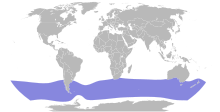Blue petrel
| Blue petrel | |
|---|---|

| |
| In flight | |
| Scientific classification | |
| Domain: | Eukaryota |
| Kingdom: | Animalia |
| Phylum: | Chordata |
| Class: | Aves |
| Order: | Procellariiformes |
| Family: | Procellariidae |
| Genus: | Halobaena Bonaparte, 1856 |
| Species: | H. caerulea
|
| Binomial name | |
| Halobaena caerulea (Gmelin, 1789)
| |

| |
| Synonyms | |

The blue petrel (Halobaena caerulea) is a small seabird in the shearwater and petrel family, Procellariidae. This small petrel is the only member of the genus Halobaena, but is closely allied to the prions. It is distributed across the Southern Ocean but breeds at a few island sites, all close to the Antarctic Convergence zone.
Taxonomy
The blue petrel was first described in 1777 by the German naturalist
The blue petrel is a member of the
Description
The blue petrel's plumage is predominantly blue-grey, with a dark "M" extending across the upperwing from wingtip to wingtip. It has a prominent black cap and white cheeks. It is white below apart from dark patches at the side of the neck. The square tail has a white tip. It has a slender black bill. It is 26–32 cm (10–13 in) in length, has a wing span of 62–71 cm (24–28 in) and weighs approximate 200 g (7.1 oz).[11]
Distribution and habitat
The blue petrel inhabits the southern oceans ranging as far north as
In 2014 a breeding colony was discovered on Gough Island (40° S, 10° W), central South Atlantic Ocean, more than 700 km north of its known and usual breeding range. Breeding here appears to take place later than at colonies farther south, so although the discovery is recent it does not necessarily represent a recent range extension.[12]
Behaviour
Feeding
The blue petrel feeds predominantly on
Breeding

The blue petrel, like all members of the
are the main danger for their eggs and chicks.Conservation status
The blue petrel has a very large range and an estimate population of 3,000,000 adult birds and thus it is rated as
References
- ^ . Retrieved 25 September 2021.
- ^ Peters, James Lee, ed. (1931). Check-List of Birds of the World. Vol. 1 (1st ed.). Cambridge, Massachusetts: Museum of Comparative Zoology. pp. 47–48.
- ^ Forster, Georg (1777). A Voyage Round the World, in His Britannic Majesty's Sloop, Resolution, Commanded by Capt. James Cook, During the Years 1772, 3, 4, and 5. Vol. 1. London: B. White, P. Elmsly, G. Robinson. p. 91.
- ^ Gmelin, Johann Friedrich (1789). Systema naturae per regna tria naturae : secundum classes, ordines, genera, species, cum characteribus, differentiis, synonymis, locis (in Latin). Vol. 1 (13th ed.). Lipsiae [Leipzig]: Georg. Emanuel. Beer. p. 560.
- ^ Bonaparte, Charles Lucien (1856). "Espèces nouvelles d'oiseaux d'Asie et d'Amérique, et tableaux paralléliques des Pélagiens ou Gaviae". Comptes Rendus Hebdomadaires des Séances de l'Académie des Sciences (in French). 42: 764–776 [768].
- ^ Rasmussen, Pamela, eds. (July 2021). "Petrels, albatrosses". IOC World Bird List Version 11.2. International Ornithologists' Union. Retrieved 1 January 2022.
- ISBN 978-1-4081-2501-4.
- ^ Gotch, A. T. (1995)
- ^ Double, M. C. (2003)
- ^ Ehrlich, Paul R. (1988)
- ^ ISBN 978-0-19-553068-1.
- S2CID 86699478.
- JSTOR 1369575.
Sources
- Double, M. C. (2003). "Procellariiformes (Tubenosed Seabirds)". In Hutchins, Michael; Jackson, Jerome A.; Bock, Walter J.; Olendorf, Donna (eds.). Grzimek's Animal Life Encyclopedia. Vol. 8 Birds I Tinamous and Ratites to Hoatzins. Joseph E. Trumpey, Chief Scientific Illustrator (2nd ed.). Farmington Hills, MI: Gale Group. pp. 107–111. ISBN 978-0-7876-5784-0.
- Ehrlich, Paul R.; Dobkin, David, S.; Wheye, Darryl (1988). The Birders Handbook (First ed.). New York, NY: Simon & Schuster. pp. 29–31. ISBN 978-0-671-65989-9.)
{{cite book}}: CS1 maint: multiple names: authors list (link - Gotch, A. F. (1995) [1979]. "Albatrosses, Fulmars, Shearwaters, and Petrels". Latin Names Explained A Guide to the Scientific Classifications of Reptiles, Birds & Mammals. New York, NY: Facts on File. pp. 191–192. ISBN 978-0-8160-3377-5.
External links
- Blue petrel on Birdlife International
- Blue petrel on ZipcodeZoo
- Blue petrel Photos
- Stamps[usurped] (for French Southern and Antarctic Territory, South Georgia and the South Sandwich Islands)
- Blue petrel videos on the Internet Bird Collection
- Blue petrel photo gallery VIREO

